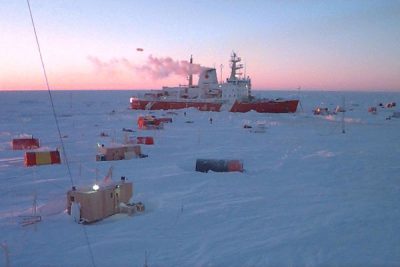SHEBA
Surface Heat Budget of the Arctic Ocean (SHEBA)
1 September 1997 - 1 September 1998
Lead Scientist: Richard Moritz
Observatory: nsa, nsa shb
The overarching purpose of the Surface Heat Budget of the Arctic Ocean (SHEBA) was to produce year-long retrievals of cloud properties, including crystal/droplet sizes, optical depths, water contents, and cloud boundaries through the depth of the troposphere. These results were intended to enhance the understanding of the thermodynamic coupling between the atmosphere and the ocean when covered with sea ice.  In 1997, SHEBA participants placed a Canadian icebreaker, DesGroseilliers, in the Arctic ice pack 570 kilometers northeast of Prudhoe Bay, Alaska. During its year-long deployment, the DesGroseilliers powered a comprehensive suite of atmospheric, ocean, and ice sensors that were operated on the ship and the surrounding ice floe. In addition, ARM deployed two dozen instruments, including a lidar and millimeter cloud radar, and gathered 10 sets of vertical profiles of clouds and aerosol properties data from over the SHEBA site. The interdisciplinary effort between ARM and NOAA for SHEBA consisted of three phases. The first began in 1995 with the examination of existing Arctic data and models, the second involved the deployment and operation of instruments as part of SHEBA field effort, and the third ended in 2002 with in-depth analysis of processes and feedback mechanisms from data obtained during the SHEBA deployment. Both ARM and NOAA contributed equipment, data, and personnel to this NSF-funded multiseason field experiment, which helped develop detailed models of physical processes on a local and aggregate scale.
In 1997, SHEBA participants placed a Canadian icebreaker, DesGroseilliers, in the Arctic ice pack 570 kilometers northeast of Prudhoe Bay, Alaska. During its year-long deployment, the DesGroseilliers powered a comprehensive suite of atmospheric, ocean, and ice sensors that were operated on the ship and the surrounding ice floe. In addition, ARM deployed two dozen instruments, including a lidar and millimeter cloud radar, and gathered 10 sets of vertical profiles of clouds and aerosol properties data from over the SHEBA site. The interdisciplinary effort between ARM and NOAA for SHEBA consisted of three phases. The first began in 1995 with the examination of existing Arctic data and models, the second involved the deployment and operation of instruments as part of SHEBA field effort, and the third ended in 2002 with in-depth analysis of processes and feedback mechanisms from data obtained during the SHEBA deployment. Both ARM and NOAA contributed equipment, data, and personnel to this NSF-funded multiseason field experiment, which helped develop detailed models of physical processes on a local and aggregate scale.
Timeline
Related Publications
2024
Liu C, Q Yang, Z Gao, M Shupe, B Han, H Zhang, S Peng, X Xi, and D Chen. 2024. "The Role of Non‐Local Effects on Surface Sensible Heat Flux under Different Types of Thermal Structures over the Arctic Sea‐Ice Surface." Geophysical Research Letters, 51(4), e2023GL106753, 10.1029/2023GL106753.
Ong C, M Koike, T Hashino, and H Miura. 2024. "Responses of Simulated Arctic Mixed-Phase Clouds to Parameterized Ice Particle Shape." Journal of the Atmospheric Sciences, 81(1), 10.1175/JAS-D-23-0015.1.
2023
Perovich D, I Raphael, R Moore, D Clemens-Sewall, R Lei, A Sledd, and C Polashenski. 2023. "Sea ice heat and mass balance measurements from four autonomous buoys during the MOSAiC drift campaign." Elem Sci Anth, 11(1), 00017, 10.1525/elementa.2023.00017.
Peng S, Q Yang, M Shupe, X Xi, B Han, D Chen, S Dahlke, and C Liu. 2023. "The characteristics of atmospheric boundary layer height over the Arctic Ocean during MOSAiC." Atmospheric Chemistry and Physics, 23(15), 10.5194/acp-23-8683-2023.
Solomon A, M Shupe, G Svensson, N Barton, Y Batrak, E Bazile, J Day, J Doyle, H Frank, S Keeley, T Remes, and M Tolstykh. 2023. "The winter central Arctic surface energy budget: A model evaluation using observations from the MOSAiC campaign." Elem Sci Anth, 11(1), 10.1525/elementa.2022.00104.
Zhang C and J Moore. 2023. "A Road Map to Success of International Field Campaigns in Atmospheric and Oceanic Sciences." Bulletin of the American Meteorological Society, 104(1), 10.1175/BAMS-D-22-0133.1.
2022
Light B, M Smith, D Perovich, M Webster, M Holland, F Linhardt, I Raphael, D Clemens-Sewall, A Macfarlane, P Anhaus, and D Bailey. 2022. "Arctic sea ice albedo: Spectral composition, spatial heterogeneity, and temporal evolution observed during the MOSAiC drift." Elementa: Science of the Anthropocene, 10(1), 10.1525/elementa.2021.000103.
Gryanik V and C Lüpkes. 2022. "A Package of Momentum and Heat Transfer Coefficients for the Stable Surface Layer Extended by New Coefficients over Sea Ice." Boundary-Layer Meteorology, , 10.1007/s10546-022-00730-9.
Liu Y. 2022. "Impacts of active satellite sensors' low-level cloud detection limitations on cloud radiative forcing in the Arctic." Atmospheric Chemistry and Physics, 22(12), 10.5194/acp-22-8151-2022.
Webster M, M Holland, N Wright, S Hendricks, N Hutter, P Itkin, B Light, F Linhardt, D Perovich, I Raphael, M Smith, L von Albedyll, and J Zhang. 2022. "Spatiotemporal evolution of melt ponds on Arctic sea ice." Elementa: Science of the Anthropocene, 10(1), 000072, 10.1525/elementa.2021.000072.
View All Related Publications
Campaign Data Sets
| IOP Participant | Data Source Name | Final Data |
|---|---|---|
| Peter Hobbs | UW- Convair-580 aircraft | Order Data |
| James Liljegren | Microwave Radiometer | Order Data |

